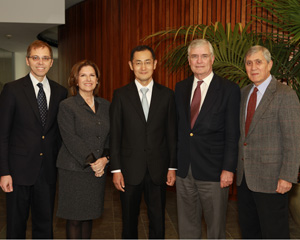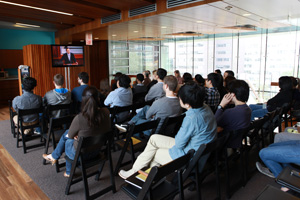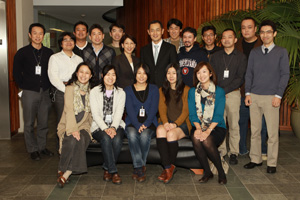

Dr. Shinya Yamanaka
Einstein Hosts Lasker Lecture
Einstein Hosts Prestigious Lasker Lecture Featuring Keynote Speaker
Dr. Shinya Yamanaka
On October 24, Dr. Shinya Yamanaka, director of the Center for iPS Cell Research and Application (CiRA) at Kyoto University, delivered the 2011 Lasker Lecture to a packed LeFrak Auditorium in Einstein’s Price Center/Block Research Pavilion. As a 2009 Lasker laureate, Dr. Yamanaka shared his revolutionary work in generating pluripotent stem cells from both mouse and human adult tissue cells. The coveted Albert Lasker Basic Medical Research Award is bestowed annually by the Albert and Mary Lasker Foundation.

(from left) Dr. Paul Frenette, Dr. Maria Freire, Dr. Shinya Yamanaka, Mr. James Fordyce and Dr. Allen M. SpiegelIn welcoming the crowd of more than 250, who also watched via video feed, Einstein Dean Dr. Allen M. Spiegel conveyed the College of Medicine’s great privilege in hosting the Lasker Lecture in conjunction with the Lasker Foundation. He then introduced Dr. Maria C. Freire, the foundation’s president. Dr. Freire explained, “The aim of the Lasker Lectures is to foster communication of great science to the public, whose support underpins most research endeavors.”
Next, employing occasional humor, Dr. Yamanaka detailed his professional journey from young medical student, to hospital resident in orthopedic surgery, to the unexpected exchange of his stethoscope for a pipette when he decided to pursue a Ph.D. in pharmacology. “My interest in basic science research was spurred by early literature I read about knockout and transgenic mice,” he said. That interest also led him to seek postdoctoral training at the Gladstone Institute of Cardiovascular Disease in San Francisco.
At the conclusion of his training, Dr. Yamanaka returned to Japan, landing a faculty appointment at Osaka City University Medical School – though he admitted suffering from what he termed “PAD,” or Post-America Depression. When, at first he received very little operational support and he had difficulty publishing his work on the functions of the NAT1 gene in embryonic stem cells, he even wondered whether he had made a mistake in pursuing science over medicine.

Watching the lecture on video feedFortunately, a personal mantra of “vision and hard work” kept him going through these ups and downs. Several years later, his adherence to the mantra bore fruit: his laboratory demonstrated that induced pluripotent stem (iPS) cells – cells that can be coaxed to develop into a variety of mature cell types such as cardiac muscle, nerves, and liver cells – can be generated from adult skin cells by treating them with a cocktail of four factors expressed in embryonic stem cells. His team announced the generation of mouse iPS cells in 2006 and human iPS cells the following year. He described how “his own heart beated” when he first observed iPS cells programmed to develop into cardiac muscle pulsating rhythmically under the microscope.
His discovery rocked the biomedical research community and unlocked the potential of stem cell research for regenerative medicine, in vitro drug screening, and toxicological studies. Moreover, if further research can identify a clinical application in regenerative medicine, the risks of immune rejection inherent in transplanting tissues between genetically unique individuals could be bypassed by using a patient’s own skin cells to generate iPS cells.
Following Dr. Yamanaka’s presentation, Einstein’s Dr. Paul Frenette, director of the Gottesman Institute for Stem Cell Biology and Regenerative Medicine, described his research, which discerns how circulation of hematopoietic stem cells between their bone marrow “niche” and the blood is regulated, and the role of the autonomic nervous system in this process. His studies not only provide insights into regulation of hematopoietic stem cell entry into the blood stream, they also show promise for expanding our understanding of how cancer cellsenter the blood stream and metastasize to distant sites in the body.

Einstein’s Japanese students, postdocs and faculty pose with Dr. Shinya Yamanaka (center) and his wife, Dr. Chika Yamanaka (to his right) At the reception following their presentations, Dr. Frenette said, “This lecture was inspiring for our students and researchers. The field of stem cell research is very exciting. I think Dr. Yamanaka’s work shows that you can ask a very big question with relatively simple technology and get an extraordinary, game-changing result.”
Indeed, the lectures did provide inspiration. “What really impressed me was how, amid many challenges, Dr. Yamanaka tackled really significant science questions rather than only pursuing projects simply for their feasibility,” said Dr. Masahide Yano, an Einstein postdoctoral researcher in microbiology & immunology.
“The research described in these two talks is going to have a great impact on the field,” added Dr. Wenjun Guo, an assistant professor of cell biology and recent addition to the Gottesman Institute who studies the pathways that govern normal mammary stem cells and how they relate to the development of breast cancer. “Einstein is putting a lot of of emphasis on stem cell research, so I think it’s a very exciting time to be here.”
For some, there also was national pride in having Dr. Yamanaka speak at Einstein. “It’s an honor, and we’re very proud of him,” said Dr. Masako Suzuki, a native of Japan who is an instructor in genetics at Einstein and studies the differentiation of embryonic stem cells.
Photo Gallery
(To view slideshow of photo gallery, click on an image below; then move your mouse over the left or right margins to navigate.)
Posted on: Wednesday, November 9, 2011










Tablet Blog